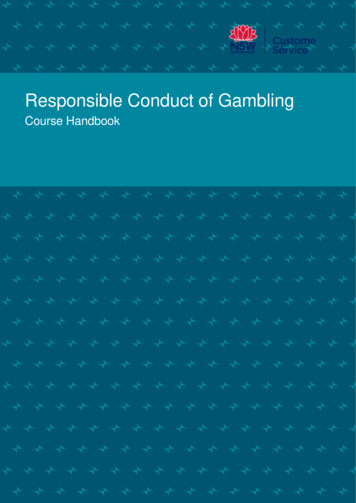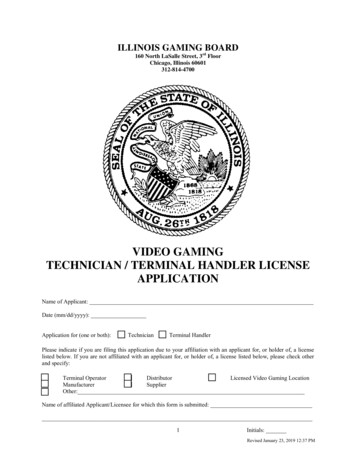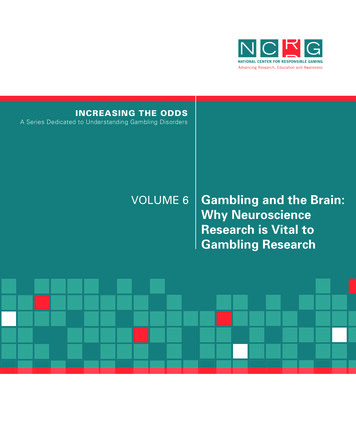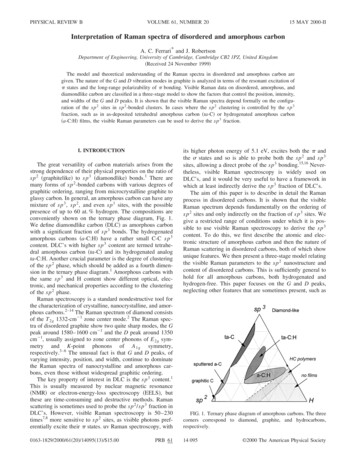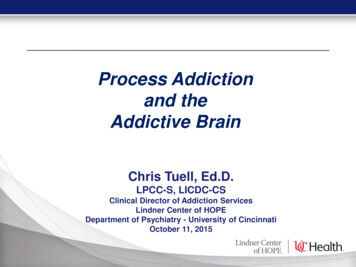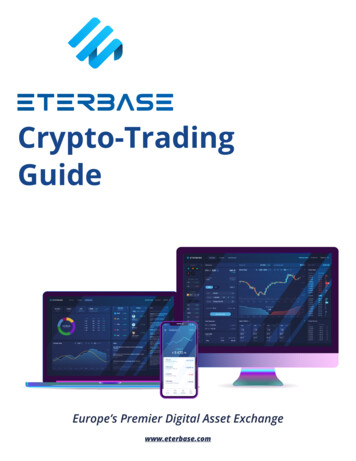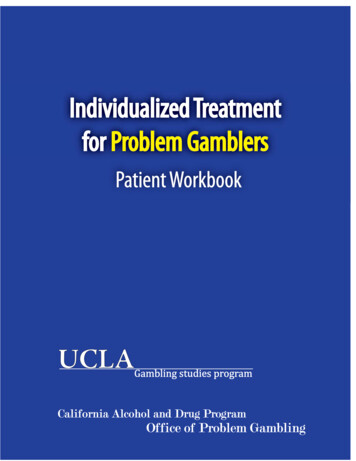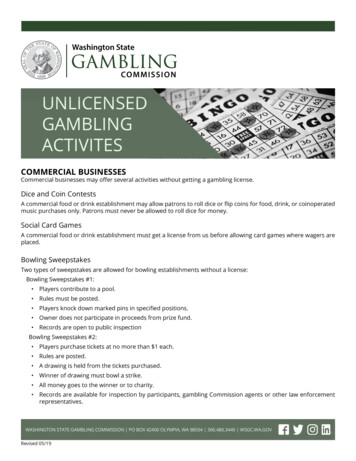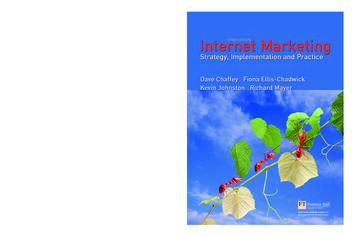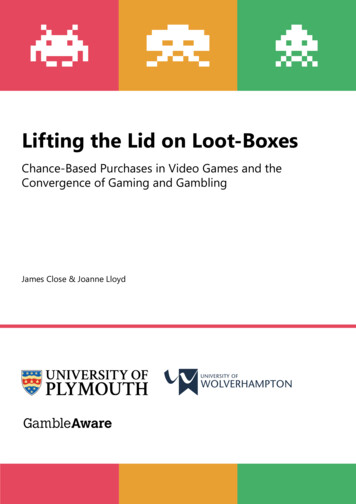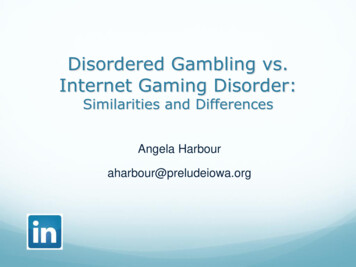
Transcription
Disordered Gambling vs.Internet Gaming Disorder:Similarities and DifferencesAngela Harbouraharbour@preludeiowa.org
Objectives Define Internet Gaming Disorder Compare and contrast related disorders Understand trends in internet gaming Differentiate between various outlets of compulsive gaming Identify populations at-risk for Internet Gaming Disorder Identify 5 steps of the Strategic Prevention Framework Utilize the Strategic Prevention Framework to develop andimplement prevention strategies
Today’s Agenda8:00-9:00- Gambling Disorder overview9:00-11:00- Internet Gaming Disorder and criteria11:00-12:00- Lunch12:00-3:00- Discuss various internet games3:00-4:30- Strategic Prevention Framework
Common Types of Gambling Lotteries Casino table games Slots Sports betting Fantasy leagues Games of skill Bingo Horse and dog racing
Other Types of Gambling Office pools (weight loss challenges) Raffles Stocks and commodities Dog fighting Beta fish fighting Others? House flipping? Storage Wars?
Gambling Disorder CriteriaPersistent and recurrent problematic gambling behaviorleading to clinically significant impairment or distress, asindicated by the individual exhibiting four (or more) of thefollowing in a 12 month period: Needs to gamble with increasing amounts of money inorder to achieve the desired excitement Is restless or irritable when attempting to cut down orstop gambling Has made repeated unsuccessful efforts to control, cutback, or stop gambling(American Psychiatric Association, 2013)
Gambling Disorder Criteria Is often preoccupied with gambling Often gambles when feeling distressed After losing money gambling, often returns another dayto get even Lies to conceal the extent of involvement with gambling Has jeopardized or lost a significant relationship, job, oreducational or career opportunity because of gambling Relies on others to provide money to relieve desperatefinancial situations caused by gambling(American Psychiatric Association, 2013)
Severity Modifiers Mild: 4–5 criteria Moderate: 6–7 criteria Severe: 8–9 criteria(American Psychiatric Association, 2013)
At-Risk Populations Adolescents For every one adult with a gambling problem, there are 3youth with a gambling problem Largest group is high school males Popular types of gambling among youth Fantasy Football and March Madness Texas Hold em’ poker Individuals in recovery for other addictions Cross addiction More than one addiction Problem gambling education
At-Risk Populations Corrections CriminalityFinancial literacyLimited access to employmentLife skillsJob skillsRepeated patterns
At-Risk Populations Senior citizens Declining healthAccess to liquefiable assetsLiving on limited incomeMeans of entertainmentCoping with loss of family and friendsDealing with depression
At-Risk Populations Military Majority are between ages 18-25Financial literacyHigh risk-takersAccess to gambling opportunitiesEntertainment to pass timePTSD and TBI
Types of Gamblers Social Gamblers Gamble for entertainment Control gambling behaviors No negative consequences associated with gambling Problem Gamblers Meet 1-3 of the criteria listed in the DSM V One criteria causing significant negative impact Disordered Gamblers Meet 4 or more of the criteria listed in the DSM V One criteria causing significant negative impact
Disordered Gambling Phases Winning Phase Losing Phase Desperation Hopelessness (Rock Bottom) Critical Rebuilding Growth
Draw the most modern slot machineyou can imagine!15
Social GamblingApplications16
Digital Slots and Casinos Any age Accessibility Availability Marketing Probability changes Use real money to buy virtual credits Big Fish Casnio17
18
Zynga Social Gambling Applications ZyngaPlusPoker and ZyngaPlusCasino 160 slots and variety of table games Real money gambling available in U.K. Welcome bonuses,cash bonuses,free money deposits19
Gaming Evolution 1970s and 1980s Pong, Space Invaders, Pac-Man Single player Only achievement was high score 1990s Doom, Quake, Mario BrothersGaming “experience”Customize virtual gaming environmentChoose weaponsCreate characters
Gaming Evolution 2000-Current Multi-player Self-contained society Economy Currency Goods and services Avatars Self-created version of oneself
Internet Gaming Disorder is not: Internet Addiction Disorder Video Gaming Addiction Internet Gambling Addiction22
Internet Gaming Disorder DSM V, Section III, as a condition warranting more clinical research and experience forinclusion as a formal disorderExcessively playing online games“Gamers” play compulsively, to the exclusionof their own interests, and their persistentand recurrent online activities result inclinically significant impairment or distressAdolescent males, 12-20 years oldPrevalent in Asian countries(American Psychiatric Association, 2013)23
Internet Gaming DisorderCriteria Severity modifiers: mild, moderate, or severe Patients must meet 5 criteria within the past year PreoccupationPsychological withdrawal symptomsToleranceUnsuccessful attempts to cut back or restrictLoss of interest in other hobbiesUse of internet games to copeDeceiving family or therapistsContinued use despite knowledge of problemAffects them at work, school, or home(American Psychiatric Association, 2013)24
Internet Gaming Disorder Excessive use, often associated with a loss ofsense of time or a neglect of basic drives Withdrawal, including feelings of anger, tension,and/or depression when computer is inaccessible Tolerance, including the need for better computerequipment, software, more hours Negative repercussions, including arguments,lying, social isolation, and fatigue25
IGD-20 Test 20 question test reflecting the nine criteria of IGD 5 point scale Incorporated components of addiction SalienceMood modificationToleranceWithdrawalConflictRelapse Can include non-internet computer games(Pontes, Kiraly, Demetrovics, & Griffiths, 2014)
IGD-20 Test Salience I often lose sleep because of long gaming sessions I usually think about my next gaming session when I amnot playing I think gaming has become the most time consumingactivity in my life Mood Modification I play games to help me cope with any bad feelings Imight have I never play games in order to feel better I play games to forget whatever is bothering me(Pontes et al., 2014)
IGD-20 Test Relapse I would like to cut down my gaming time but it’s difficult todo I do not think I could stop gaming I often try to play games less but find I cannot Withdrawal Symptoms When I am not gaming I feel more irritable I feel sad if I am not able to play games I tend to get anxious when I cannot play games for anyreason(Pontes et al., 2014)
IGD-20 Test Conflict I have lost interest in other hobbies because of my gamingI have lied to my family members because of the amountof gaming I doI know my main daily activity (i.e., occupation, education,homemaker, etc.) has not been negatively affected by mygamingI think my gaming has jeopardized the relationship withmy partnerI believe my gaming is negatively impacting importantareas of my life(Pontes et al., 2014)
IGD-20 Test Tolerance I have significantly increased the amount of time I playgames over the last year I need to spend increasing amounts of time engaged inplaying games I often think that a whole day is not enough to doeverything I need to do in-game Differentiate between “high-engagement” and addiction(Pontes et al., 2014)
Case StudiesBoth spend an average of 14 hours/day playingAged 21 years, unemployed and single, “Dave” reported thatgaming had a positive influence on his life because his social liferevolved almost exclusively around the game, and playingboosted his self-esteem and gave structure to his everyday life.Dave did not perceive that his excessive gaming impacted uponhis life negatively at all. For Dave, his extensive gaming did notlead to significant distress or have a negative impact in his dailylife, and therefore his behavior cannot be classified as acondition that would fulfill the requirements of a mental disorderclassification as outlined in the DSM-5. Upon starting a new joband entering into a relationship with a woman he met in-game,his excessive gaming decreased significantly.31(Griffiths, 2012)
Case Studies“Jeremy”, a 38-year old financial accountant who was marriedwith two children. He experienced detrimental consequencesdue to his “severe gaming addiction”, namely a relationshipbreakdown, lack of time for family activities, and loss of his job.Moreover, his playing time, craving for the game, and feelingsof low mood and anxiety had increased dramatically. He usedgaming to escape from his real-life problems and tried to quiton several occasions, but was unsuccessful in stayingabstinent. This led to a number of relapse episodes.(Griffiths, 2012)
Internet Gaming Disorder Development of Internet Gaming Disorder Begins with preoccupationLoss of interest in other activitiesSocial withdrawalLying or hiding gaming useDefensiveness and angerPsychological withdrawalContinued use despite consequences(Young K., 2009)33
Compulsion Loop The compulsion loop is similar to ones producedby excessive gambling 2 types of games that produce compulsivesymptoms MMORPGs Maximize length of play session Social Application Games Maximize number of sessions Positive reinforcement34
MMORPGs Massively Multiplayer Online Role Playing Game Persistent world Continual avatar progression Social games No save-point Appeal to both sexes and most age groups(Kuss, 2013)
MMORPGs Primary MMORPGs World of Warcraft https://www.youtube.com/watch?v c9 IRl1AYlsEverQuestGuild WarsEve OnlineDark Age of Camelot36
MMORPGs Who plays MMORPGs Primarily males20% femalesAverage age of male player is 26 years oldAverage age of female player is 32 Average gamer spends 25 hours/week playing 1/10 gamers play in excess of 40 hours/week37
MMORPGS Motivations to play Mechanics and story lineAchievement/Leveling-upAcquiring status and powerReputation within gaming communityCompetition and challengesCreates a new identityIncreases self-esteemWay to develop relationshipsFeel a sense of comraderyCoping and escapism(Kuss, 2013) 38
MMORPGs Motivations associated with addiction Coping and escapismOnline relationshipsAchievement and masteryReputation and recognitionChallengesDependent players preferred on-line friendsNon-dependent players satisfied with real-life socialinteractions Motivations for choosing to play can be an indicator forof potential risk for developing addiction (Kuss, 2013)
MMORPGSAre these games designed to be addictive? Experience and progress bars Multiple aims, short and long term Reward for effort Feedback Uncertainty CommunityAnthony Rosner Documentaryhttp://www.youtube.com/v/K4W0uHG77Zc40
Social Application Games Structured games with contextual rules throughwhich users can engage with one another. Toqualify as a social gaming application, gamesmust be multiplayer, provide user with an identityand may include one or more of the followingfeatures: Turn-based Based on a social platform Often will be child’s first introduction to gaming41
Name that App!Clash of ClansFruit NinjaCandy Crush SagaPlants vs. ZombiesAngry BirdsSubway SurfersCrossy RoadTrivia Crack
Social Application Gaming Start out playing for free Build a profile/identity/status Small successive goals Cooperative goals Build relationships May be some buy-in43
Why is social gamingpopular? New technology Variety of topics Appeal to older and younger population Friendly competition between friends Power of social media Low intensity, action44
Polling QuestionDisclaimer: This is a judgment free zone!How many of you have played a social gamingapplication:In the past day?In the past week?In the past month?
U.S. Stats Percentage of American adults that own a cell phone? 90% Percentage of American adults that own a tablet? 42% Percentage of downloaded applications that aregames? 70-80% Percentage of American adults that are mobilegamers? 33%
U.S. Stats The average age of a mobile gamer? 28.2 Estimated revenue of mobile gaming 2015? 54 billion (estimated) Hint: 2011: 12 billion Estimated revenue of mobile gaming in 2016? 108 billion (estimated)
Social Application Gaming Current top gaming applications Clash of ClansMinecraftTrivia CrackCandy Crush SagaCandy Crush Soda SagaBig Fish CasinoHay DayZynga’s Texas Hold’em Poker48
Trivia Crack Among the top free apps in more than 20 countries 5th most played game in the WORLD Play against Facebook friends Challenging and simple, without being frustrating 700,000 daily downloads in the U.S. Second release of the game coming in 2015 Players create their own categories Mini-games
Trivia Crack
Flappy Bird https://www.youtube.com/watch?v V1lPHTpjIC0 Released in May, 2013 Estimated that profits were about 50,000 daily Discontinued in February, 2014 “It happened to become an addictive product. I think ithas become a problem. To solve the problem, it’s best totake down Flappy Bird. It’s gone forever.” Phones preloaded with app sold for over 20,000 onEbay
Free to PlayAKA Wait to Play or Pay to Play Download app for free Ad supported Pay money AdvantagesExtra levelsMore plays/livesNew objectsTime Virtual credits
Virtual Credits Most games have a currency Free Paid Time investment increases value of currency Second Life Linden dollars
Why are Apps so Addictive? Simplicity Ability to multitask Anytime, anywhere One hand play Mentally stimulating Compulsion loop Illusion of control Repetitive action followed by positive feedback Loss aversion
ZyngaOne of the leading social applications networks Created in 2009 Hosts games Farmville and Texas Hold’em Poker Has over 60 million regular players Has a net worth of over 1.6 billion55
Gambling within Social GamingApplicationsTom Chatfield7 Ways Gaming Rewards the Brainhttp://www.ted.com/talks/tom chatfield 7ways games reward the brain?language en#t-75285556
Social GamblingApplicationsSocial GamesNo relation togambling themes,limited use of moneyPlay with virtualmoneyFantasyLeagues, Skillgames withprizesSocialGamblingPlay with realmoneyFew examples inU.K.57
Faces of Internet Gaminghttps://www.youtube.com/watch?v HfOUhwhdUV0 Robbie Cooper, British photographer “Immersion Project” Youth playing games Do any of these faces stick out to you?
Strategic Prevention Framework (SPF) Assessment Capacity Planning Implementation Evaluation
Questions?Angela Harbouraharbour@preludeiowa.org515-729-6615
ReferencesAmerican Psychiatric Association. (2013). Diagnostic and statistical manual of mentaldisorders (5th ed.). Washington, DC.Gentile, D. Pathological video-game use among youth age 8-18: A national study.Psychological Science, 2009; 20, 594-602.Griffiths MD. The role of context in online gaming excess and addiction: some casestudy evidence. International Journal of Mental Health and Addiction. 2010;8:119–125Kuss DJ. Internet gaming addiction: current perspectives. Psychology Research andBehavior Management. 2013;6:125–137.Pontes HM., Kiraly O., Demetrovics Z., Griffiths MD. (2014) The Conceptualisation andMeasurement of DSM-5 Internet Gaming Disorder: The Development of the IGD-20Test. PLoS ONE 9(10): e110137. doi:10.1371/journal.pone.0110137.Young K. Understanding online gaming addiction and treatment issues for adolescents.American Journal of Family Therapy. 2009;37:355–372.
Achievement and mastery Reputation and recognition Challenges Dependent players preferred on-line friends Non-dependent players satisfied with real-life social interactions Motivations for choosing to play can be an indicator for of potential risk for developing addiction (Kuss, 2013)
